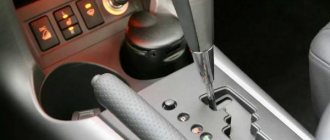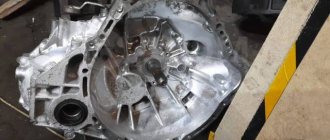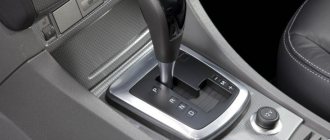Advantages and disadvantages of the box
When choosing a car, the driver is always faced with the question of which transmission is better to choose, since at first glance it may seem that there is not much difference between them. By choosing any of the above, in addition to mechanics, the driver receives a number of positive aspects, such as:
- The chassis with the engine is protected from overloads;
- Smooth running of the car;
- There are no jerks at the start or when changing gears;
- Makes it easier for beginners to control;
- With careful use it has a long service life.
As for the disadvantages of automatic transmissions, these include:
- High fuel consumption compared to classic mechanics or a robot.
- If your driving style is active, then the automatic machine will have high operating costs, since you will need to change consumables and oil more often;
- Maintenance is more expensive than a robot.
Unlike a robot, an automatic transmission has a shorter resource, and due to higher engine speeds, gasoline consumption is higher. Judging by the reviews, the automatic transmission is excellent for powerful engines with high traction; such a transmission will feel especially good over long distances where high speed is required.
Important! If you are purchasing a car to cover long distances, then an automatic transmission is perfect for you.
It is precisely because of the lack of power that car owners change the robot to an automatic one.
Automatic transmission Toyota U340, U341E. general review
U340/U341 is a four-speed automatic transmission, which has been installed since 2000 on front-wheel drive Toyota cars with an engine of up to 2 liters.
Transmission U341E - used for more powerful 1.8 liter Celica engines. U341F - modification for vehicles with all-wheel drive.
These automatic transmissions were installed on the following cars:
- Toyota: Corolla E120, Avensis T250, Yaris XP10, Celica, ECHO, FUNCARGO, PLATZ, PROBOX, CALDINA. MATRIX;
- FAW VELA.
Main malfunctions of automatic transmission Toyota U340, U341E.
On runs from 150 thousand km. The valve body and EPC line pressure solenoid may fail. Shift solenoids may fail. Symptoms: jerking/kicks in a warm automatic transmission.
The torque converter also has a comparable resource. The symptom is vibrations.
On runs of more than 200 thousand km. The clutches gradually fail - the oil turns black from their wear products. The symptom is slippage.
On long runs more than 250 thousand km. wear occurs on the planetary gears. Symptoms: crunches, impacts, refusal to move. The oil in the box will contain metal shavings.
An oil leak from the pump seal is common. They change it together with the bushing.
Due to the weak back cover, the Revers drum sometimes drives in the box.
With proper operation, this automatic transmission can last 250-300 thousand kilometers until the first breakdown.
Diagnostics of automatic transmission Toyota U340, U341E.
Most questions about the causes of the malfunction can be answered immediately after the initial diagnosis. The transmission is easy to diagnose. An experienced craftsman can determine 90% of the upcoming repair work even from a conversation with a client. To do this, it is enough to obtain information from the client about the symptoms of the malfunction, how many times and how the oil was changed, what color of the oil and whether there are chips in the pan, how many owners the car had, whether additional cooling of the automatic transmission was installed, etc.
As part of the initial automatic transmission diagnostics, computer diagnostics are performed, an oil sample is taken, and the symptoms of malfunctions are analyzed.
The main results of the primary diagnosis:
— automatic transmission fault: yes/no;
— repair of the electrical part of the automatic transmission is required (braid, sensors, connectors): yes/no;
— only valve body repair is required: yes/no;
— repair of the hydraulic part (valve block, torque converter) and mechanical part is required: yes/no.
If there are problems with the mechanical part, then most likely there are problems with the valve body - wear products from the “mechanics” clog the solenoids and valves of the valve body.
To understand what exactly is broken in the mechanical part, you will need to remove, disassemble and defect the box. After the troubleshooting procedure, the list of spare parts to be replaced will be finally determined.
Automatic transmission repair Toyota U340, U341E.
A typical bulkhead is as follows:
- The clutches are replaced with new ones;
- The hydraulic unit is repaired and cleaned;
- The torque converter is being repaired;
- The line pressure solenoid is replaced with a new one;
- The reverse drum changes along with the calipers and Teflon rings;
- The pump seal is replaced along with the bushing.
Buying a used Toyota car with automatic transmission U340, U341E.
Transmission repair is one of the most expensive types of repairs along with the engine, so when buying a used car you need to do diagnostics, both electronic and mechanical, take an oil sample, see if it is burnt, and conduct an intensive test drive in all modes : Traffic jam mode, Grandfather mode, Racer mode. If the oil is burnt, this means that the friction clutches are burnt. The smell of burning is a serious symptom that must be feared; if it already exists, it will only progress until repair of both the hydraulic and mechanical parts of the transmission.
Toyota automatic transmission service
An important factor in the long-term and uninterrupted operation of an automatic transmission is its maintenance. For this box we recommend:
- Cleaning radiators (at least once every two years);
- Installation of additional cooling;
- Periodic diagnostics of automatic transmission;
- Regular oil changes. The first two replacements should be made every 60 thousand km. mileage More frequent replacement is possible if desired. Subsequent replacements, due to the formation of increasingly large wear products, must be made every 40-45 thousand km. mileage and partial replacement method.
If you need to buy a used automatic transmission Toyota U340, U341E.
If there is more specific information on a specific instance of a used automatic transmission, including mileage and make/model of the car, then you can use a “used” one. If this information is unknown, how and what was exploited, then this option is a “pig in a poke.” When selecting a used automatic transmission, you need to select it in accordance with the serial numbers (transmission models), because there may be differences:
- by fastening;
- electronic control of the valve body;
- gear ratio and number of teeth on the shafts/gears.
A discrepancy between the box model after installation will result in the appearance of an emergency mode, or a complete failure of movement, or the box will simply be technically impossible to install.
Tow truck.
If a warm Toyota automatic transmission has slight kicks/jerks, then you can get to the service center under your own power. But if there are already crunches, noises, gear failures, and slippage, then you need to call a tow truck. Otherwise, the transmission will wear out catastrophically when operating under faulty conditions. This will lead to higher repair costs. It is better to use a tow truck to ultimately reduce the cost of repairs.
If you have any questions, write comments under this article, or call our specialist directly. The phone number is listed in the “Contacts” section. Also, through any messenger you can send the technician photos of spare parts, error codes, etc., or you can also call and consult on any issue.
Operating principle of continuously variable transmission
The appearance of a CVT installed in a car is practically no different from the appearance of automatic transmissions installed in a car. The same panels, there are also only two pedals - gas and brake, the same levers that have several modes - parking, reverse gear, neutral gear and D - the main driving mode, which uses the gear range from first to fourth. However, in essence the device and the principle of its operation are completely different from an automatic transmission. Its structure is as follows: in this transmission there is no specific distribution of speeds like in an automatic transmission, for example, first, second, third...sixth. There can be as many of them in the variator as you like, and their switching occurs smoothly and, most importantly, unnoticed by the driver of the Toyota Corolla.
It is this approach to the operation of the transmission that allows you to avoid hard shocks and clearly visible gear changes, and so on. The essence of the CVT operation is that inside the transmission there is a smooth change in the gear ratio when accelerating and braking Toyota without bright jumps and gear changes.
Main modes:
This mode is used when parking. You can turn it on only after the car has come to a complete stop on a level surface. The transition to “P” mode is carried out before the brake pedal is released. After switching, the motor will be disconnected from the transmission. An additional gear is used for locking.
Important: if you use “P” while driving, you can break the locking gear, which can lead to expensive engine repairs.
Also, you cannot use the described mode without the car’s hand brake, when parking on a slope exceeding 15 degrees.
Reverse driving mode. Reverse can only be activated after the vehicle has come to a complete stop. Before starting to move backwards, you should wait approximately 1.5 seconds. Without pressing the lock button on the automatic transmission handle, you can only switch from this mode to neutral.
Neutral gear. In it, the engine idles (does not transmit torque to the wheels). Typically, neutral is used for short stops. It is highly not recommended to engage neutral gear until the car has stopped. Neutral is also used when towing a car. In this case, towing should take place at a speed no higher than 45 km/h (and for a short time).
You can return to the same mode without removing the button from the “Drive” mode when you come to a complete stop.
"D", "D1", "D2", "D3"
The main operating mode of the automatic transmission is indicated by the letter “D”. Driving in 4 gears. In this mode, depending on the current pressure of the gas pedal, the electronics itself will downshift or upshift.
Modes designated simply by numbers (1, 2, 3) or the letter “D” with one of the numbers mean lower gears. Accordingly, in 3 gear the box will not shift above third gear. In 2nd gear the automatic transmission will not shift above 2nd gear.
Mode “D1” or “1” or “L” is the use of only first gear. It is used in cases where the vehicle speed cannot exceed 25 km/h. Under no circumstances should this mode be activated while driving at high speed! Otherwise, loss of control and skidding may occur. “Unity” is also used in situations where you need to make full use of the car’s engine braking capabilities.
Types of CVT
Today, there are three different types of variator, which differ from each other in the principle of their operation. Let's look at each of the types.
The first is a clinometer variator. Here the coordination of the diameters of the pulleys, which occurs completely depending on the operating mode of the engine, is what ensures the operation of a CVT gearbox of this type. Inside it there is a special drive that can change the size of the pulley up or down. At the moment when the car starts to move away, its size is minimal, and the size of the drive pulley is the largest. However, when the car begins to pick up speed and revs, its size gradually increases and the size of the pulleys changes in opposite directions to each other. That is, the driving pulley decreases, and the driven pulley increases. This is the whole meaning and operating principle of this type of transmission; now it’s worth talking about the next type.
The second type is a toroidal variator. Here the principle of operation is that the variator has two coaxial shafts, which have a spherical surface, and between them, in turn, rollers are clamped, and when they move, the gear ratio changes. Torque in this mechanism is transmitted due to the friction force between the working surfaces of the rollers and wheels. Both types are very interesting. They are used in the production of Toyota Corolla to this day.
However, it is worth noting that Japanese manufacturers began to pay increasing attention to the clinometer type of variators - they were installed in the 2013-2014 model. Now we have come to the moment when we can consider in more detail the advantages and disadvantages of this type of variator installed in the Corolla.
Letter designations on the automatic transmission box
Don't be scared when you see unfamiliar letters. To begin with, it is better to master the simplest ones - D, P, and R. Which indicate forward movement, parking and reverse. Once you get used to it, you can experiment with others. Let's look at what all these letters mean.
D or A (Drive or Automate)
Different designations for the same mode. By turning on D or A, we get the car moving forward normally. The box itself determines the required gear corresponding to the speed of movement. Used when traveling under normal conditions in the city and highway, without extreme ascents and descents. By turning on Drive (Automate), the driver can forget about changing gears until the car stops.
Selecting D or A is ideal for drivers with little experience. Makes you forget that the car has a gearbox. The machine will do everything for you.
M (Manual)
This is manual gear shift mode. On some models, it is turned on by simply touching the + or - switch blades.
Suitable for those who want to drive a car, changing gears themselves. It allows you to move very well on broken roads, off-road and in extreme conditions.
N (Neutral)
A familiar designation for neutral mode, similar to manual transmissions. All wheels are unlocked, but the car will not move without external influence. Such impact is understood as unauthorized rolling from a descent, towing or pushing.
Can be used for short stops and for towing. You cannot drive in neutral!
P (Parking)
Trivial parking. Used for long-term parking. Switching on is possible only when the machine is completely stopped. If the car is stopped on a slope, you must first tighten the handbrake lever. After parking, all wheels are locked. Through Parking you can switch to any mode and start driving.
R (Reverse)
As with manual shift cars, reverse gear is engaged. Reverse - driving only in reverse. You only need to turn it on when the car is completely stopped!
Additional modes
This is the normal operating mode of the automatic transmission without the use of “special effects”.
The so-called “economical” mode of operation of the automatic transmission. Used to ensure smooth, calm, measured movement of the machine. It is used in cases where you want to significantly reduce fuel consumption and the amount of harmful emissions.
Sport mode is the exact opposite of “economy” mode. Automation allows the box to use engine power to its fullest. There can be no talk of any fuel economy in sport mode. The car becomes more “dirty” and “gluttonous”, but the acceleration becomes really sharp.
"Upshift" or "overdrive" function. As a rule, overdrive is activated by a separate button on the automatic transmission lever. The transition (or exit) to this mode is indicated by a separate symbol on the dashboard. Essentially, this is engaging the extreme fourth or extreme fifth gear in the box. You can switch to “overdrive” only at speeds of 75-110 km/h. Moreover, this mode should be exited at speeds below 70 km/h. The main advantage of “overdrive” is the increase in vehicle dynamics and fuel economy at high speeds.
Winter mode. Found in some automatic transmissions. Sometimes indicated by a snowflake. Used exclusively when starting on a slippery surface. When switching to this mode, the transmission will start immediately from second or third gear.
Repair or change?
If you monitor the level and quality of the oil, change it as necessary, and also update filters and parts that wear out quickly, you can do without major repairs for a long time.
Most often, oil seals, gaskets, friction and steel discs, clutch locking linings, and pump bushings need to be replaced. In many models, the back cover must be replaced (it is not considered a consumable, but wears out intensively). If the problems are related to broken wiring or oxidation of the contact, their elimination will not cost much; diagnostics will be much more expensive - after all, you will have to check many wires and terminals. But such breakdowns are not fatal. A number of problems can be solved by replacing sensors.
More extensive types of repairs include replacing the solenoid block (required if the hydraulic plate breaks) or the entire valve body. Sometimes they try to repair the electronic control unit, but this rarely works, so replacement is more reliable. In case of large-scale damage to the automatic transmission, it is necessary to completely overhaul, clean and rinse contaminated components, troubleshoot parts and replace damaged and heavily worn ones.
Sometimes it is more cost-effective to replace an automatic transmission than to try to revive it
The owner usually makes the decision to replace the automatic transmission after the technician at the service center announces the cost of major repairs or pronounces the verdict: “It cannot be restored.” Computer diagnostics allows you to determine the cause of problems and determine the estimated cost of repairs. Detailed diagnostics with determination of the scale of the problems require dismantling and disassembling the automatic transmission. If the car has been driven for a long time on burnt oil, then more than half of the components are worn out and it is more cost-effective to replace the entire automatic transmission.
Recommendations for increasing the service life of automatic transmissions
- systematically warm up the car before each time you leave the garage;
- undergo technical inspection strictly according to the approved schedule. An increase in interval is allowed, but not more than 500 km;
- fill the transmission fluid strictly in accordance with temperature indicators, observing the viscosity coefficient;
- do not exceed the permitted speed limit;
- Avoid slipping and over-gearing. If necessary, keep the tachometer needle in the green - yellow zone, balance the load with rest for the automatic transmission.










